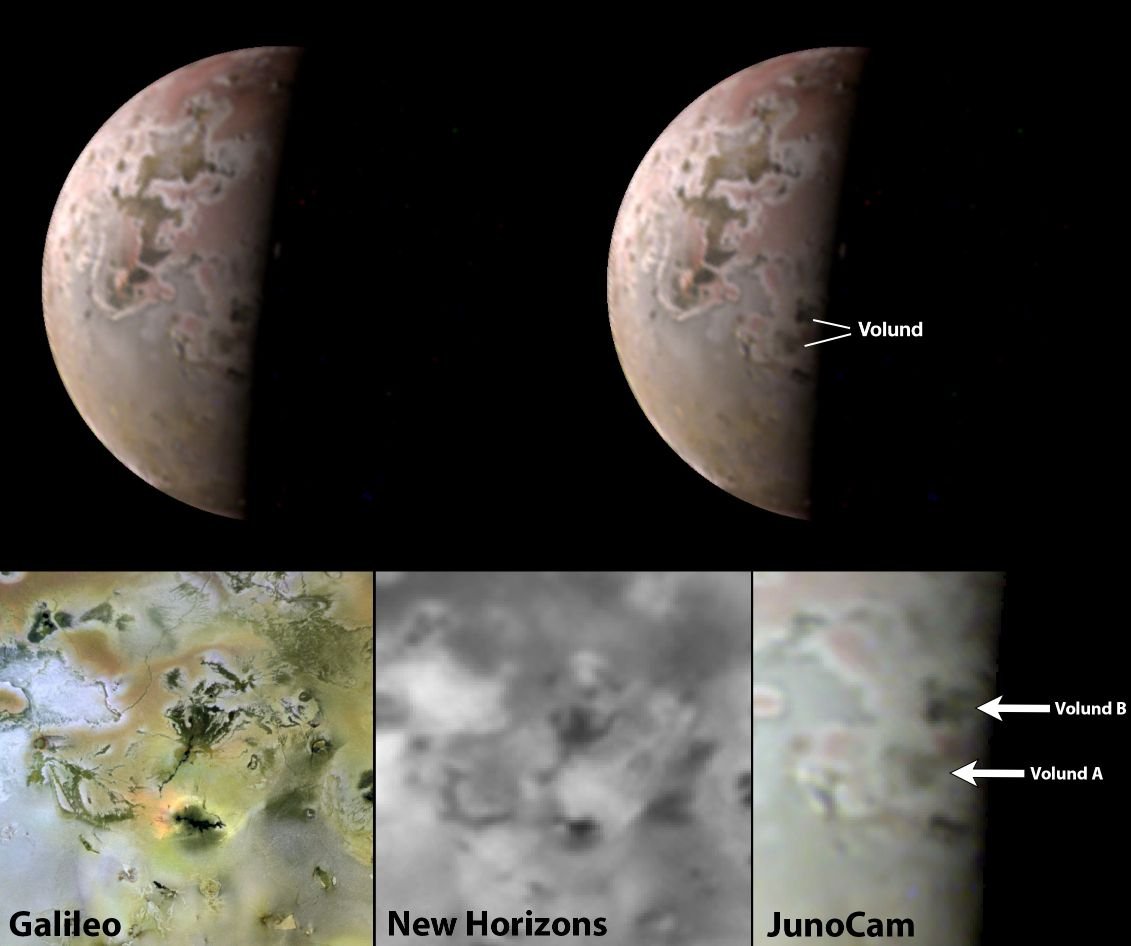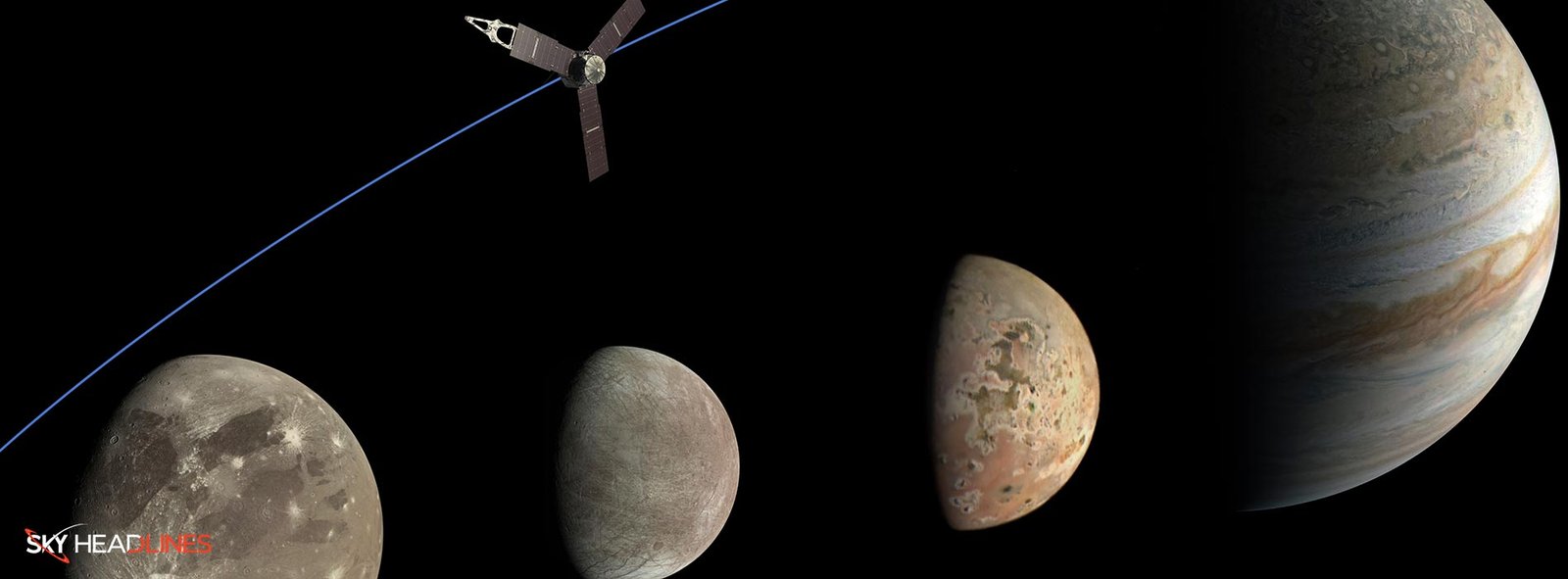NASA’s Juno mission is going to fly by the moon io of Jupiter on July 30, 2023. And this spacecraft is going to make its nearest approach to the planet.
Will Juno’s Mission Explore Volcanoes of Moon Io of Jupiter?
On July 30, NASA’s Juno mission will conduct another examination of Jupiter’s fiery moon, Io. This time, the solar-powered spacecraft will make its closest approach yet, coming within 13,700 miles (22,000 kilometers) of the moon. During this flyby, the Italian-built JIRAM (Jovian InfraRed Auroral Mapper) and other science instruments will collect valuable data, offering insights into the moon’s numerous erupting volcanoes that spew molten lava and sulfurous gases across its surface.
Juno Principal Investigator Scott Bolton of the Southwest Research Institute in San Antonio remarked that while JIRAM’s primary purpose was to observe Jupiter’s polar aurora, its ability to detect heat sources has proven crucial in identifying active volcanoes on Io. As Juno approaches the moon with each flyby, JIRAM and other instruments on board contribute to an ever-growing repository of data about Io. This accumulation not only aids in a more detailed examination of surface features but also enables a better understanding of their dynamic changes over time.

What is the Recent Discoveries in Moon Io of Jupiter So Far?
The spinning, solar-powered spacecraft, launched in 2011, has been studying the Jovian system since 2016. It is set to begin the third year of on July 31.
Io, slightly larger than Earth’s moon, is a world in constant turmoil. Gravitational forces from Jupiter and its Galilean siblings, Europa and Ganymede, continuously pull and stretch the moon. And contributing to the ongoing eruption of lava from its many volcanoes.
During Juno’s previous flyby of Io on May 16, the JunoCam imager captured an image from 22,100 miles (35,600 kilometers) showing a smudge in the moon’s Volund region, near the equator. These smudges act as valuable clues for planetary scientists, indicating changes on the surface of the moon.
Jason Perry of the University of Arizona’s HiRISE Operations Center in Tucson pointed out the expansion of the lava flow field to the west. And the fresh lava flows surrounding another volcano just north of Volund. And comparing it to visible-light images taken during Galileo and New Horizons flybys in 1999 and 2007. This direct observation of changes on Io’s surface after 16 years is an exciting development for researchers studying its extreme volcanic activity.
Moon Io of Jupiter: Moon with Hundreds of Erupting Volcanoes
Jupiter’s moon, Io, stands as the most volcanically active world in our solar system. Which is boasting hundreds of volcanoes, some erupting lava fountains that can reach dozens of miles (or kilometers) in height. The impressive activity on Io is a consequence of a constant interplay between Jupiter’s powerful gravity. And the smaller yet precisely timed gravitational pulls from its neighboring moons, Europa and Ganymede, which orbit farther from Jupiter.
In size, Io is slightly larger than Earth’s Moon and ranks as the third largest of Jupiter’s moons, occupying the fifth position in terms of distance from the gas giant.
Io’s orbit around Jupiter is influenced by the large moons, Europa and Ganymede. They results in an irregularly elliptical path. Consequently, Io is subjected to significant tidal forces, causing its surface to bulge up and down (or in and out) by up to 330 feet (100 meters). This tidal effect far exceeds the tides experienced on Earth’s oceans, where the difference between low and high tides is only about 60 feet (18 meters) in water, not solid ground.
How does the Proximity of Moon Io of Jupiter will Spark Lightning and Transform its Surface?
Due to its proximity to Jupiter at approximately 262,000 miles (422,000 kilometers). The orbit of Moon io has cuts across the planet’s powerful magnetic field lines, effectively turning the moon into an electric generator. Io can develop a staggering 400,000 volts across its surface, generating an electric current of 3 million amperes. This electric current travels along Jupiter’s magnetic field lines, resulting in lightning within Jupiter’s upper atmosphere.
The tidal forces produce an immense amount of heat within Io, keeping much of its subsurface crust in a liquid state. This causes the moon’s surface to constantly renew itself, filling in impact craters with molten lava lakes and spreading smooth new floodplains of liquid rock.
The exact composition of this material remains somewhat uncertain, with theories suggesting it may primarily consist of molten sulfur and its compounds (explaining the varied coloring) or possibly silicate rock (which better accounts for the extreme temperatures, possibly too hot for sulfur). The thin atmosphere of moon Io mainly comprises sulfur dioxide, and unlike the other Galilean moons, it lacks water. Data from the Galileo spacecraft indicates that Io may have an iron core, thus possessing its own magnetic field.
How Does the Moon’s Interaction with the Gas Giant Shape Auroras, Plasma Torus, and Reveal Planetary Orbits?
As Jupiter rotates, its magnetic field interacts with Moon Io. Which is causing about 1 ton (1,000 kilograms) of Io’s material to be stripped away every second. This material becomes ionized in the magnetic field, creating a doughnut-shaped cloud of intense radiation known as a plasma torus. Jupiter’s atmosphere pulls some of these ions along the magnetic lines of force. Which results in auroras in the planet’s upper atmosphere. Additionally, ions escaping from this torus contribute to inflating Jupiter’s magnetosphere to more than twice its expected size.
If we look onto the previous history of Moon Io. Then Io was first discovered on January 8, 1610, by Galileo Galilei. This discovery, along with three other Jovian moons, marked the first time scientists. As they found a moon orbiting a planet other than Earth. The observation of these four Galilean satellites ultimately led to the realization that planets in our solar system. Which are revolving around the Sun, contrary to the previous belief that our solar system revolved around Earth. Galileo’s initial observation of Io occurred on January 7, 1610. But he was unable to distinguish between Io and Europa until the following night.
How did Jupiter’s Moons Receive Their Names and What Stories Lie Behind Io’s Name?
Originally, Galileo referred to Jupiter’s Moon io as the Medicean planets, naming them after the influential Italian Medici family. He labeled the individual moons numerically as I, II, III, and IV. This naming system persisted for a couple of centuries.
However, it wasn’t until the mid-1800s that the names we now use for the Galilean moon. Io, Europa, Ganymede, and Callisto—were officially adopted. The shift occurred mainly because as astronomers discovered more moons around Jupiter and other planets, using numbers became confusing.
In mythology, Io undergoes a transformation into a cow due to a marital dispute between Zeus, the Greek god. Which is (also known as Jupiter in Roman mythology), and his wife, Juno.
What’s in the Name of Juno Mission and its Mythological Connection?
NASA named the Juno mission in honor of Juno. Who, according to mythology, possessed the ability to see through clouds and reveal her husband’s misdeeds. Similarly, the Juno spacecraft peers through the clouds of Jupiter to unveil the secrets hidden beneath.
Regarding the potential for life, Io is not a favorable destination due to constant volcanism and intense radiation. Which make it an inhospitable environment for life as we know it.





